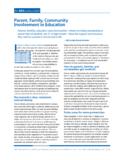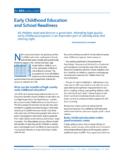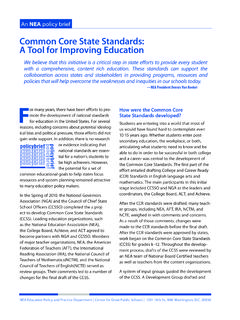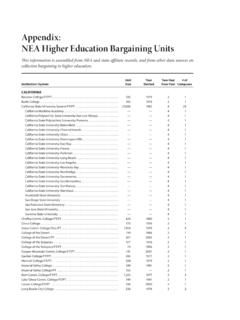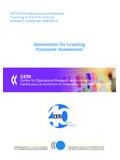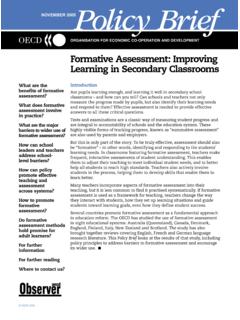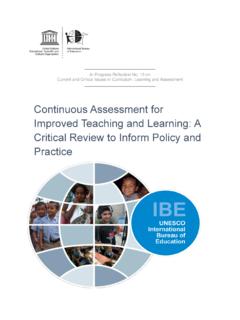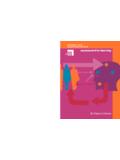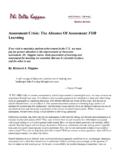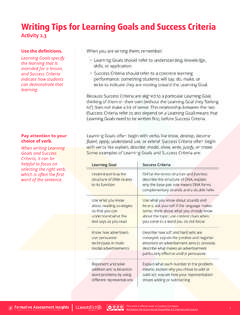Transcription of Teacher Assessment and Evaluation - NEA Home
1 N a t i o n a l e d u c a t i o n a s s o c i a t i o n | 1 2 01 16 t h S t. , N W, W aS h iN g t oN , D . C . 2 0 0 3 6 The challenges of TeachingTeaching is a demanding and complex profession. Each school day, countless dedicated, talented teachers report to work intent on being the caring, competent, and effective educator that every student deserves. Many teaching professionals work in under resourced schools and in jobs that are incredibly challenging and complex. They can attest to the fact that teaching is not rocket science. In many ways, teaching can be even more challenging than scientific endeavors.
2 Meeting the demands of the teaching profession requires tremendous will, ability, and preparation. It also requires continuous learning and support. The role of Teacher evaluaTionEvaluation is only one component of a comprehensive Teacher growth and development system. The public education system involves many stakeholders whose various roles and responsibilities aim to support and enhance student learning. Unfortunately, within the education system itself, there is a lack of alignment and coherence. Efforts to reform a single component, such as Teacher Evaluation , cannot produce a silver bullet.
3 Focusing on only one component can lead to reforms that merely tinker around the edges. When trying to fix what appears to be broken, we may end up leaving flawed systems and structures intact. True reform of Teacher Evaluation and Assessment needs to be considered in the larger context of transforming the education system. NEA advocates the development of new systems of teaching and learning that align student and Teacher Assessment with the ultimate goal of improving both. The following concept map shows how student learning standards can have a systemic connection with Teacher education and Assessment .
4 To design and implement productive Evaluation and Assessment programs, we need to recognize two essential points:Initially, preparation and hiring are the most critical ways to assure Teacher effectiveness. Before becoming Teacher Assessment and Evaluation :The National Education Association s Framework for Transforming Education Systems to Support Effective Teaching and Improve Student LearningNEA recognizes the urgent need to transform the education system to support effective teaching and improve student learning. Based on its vision of great public schools for every child, NEA has identified the core purposes and values of a comprehensive Teacher growth and development system to meet the demands of the 21st century.
5 Concept Map for Standards-Based Learning and Assessment System Teacher Standards Teacher Preparationand LicensureJob-Embedded PDAssessment ofTeacher PracticeAssessment ofStudent Learning Teaching andLearning Process StudentLearning:Academic ContentCritical Thinki ngCaring and CreativeNew Teacher In troduction and Support Rich,MeaningfulCurriculumProductive Structure andClimateAdequateLearningResourcesStude nt Standards 2n a t i o n a l e d u c a t i o n a s s o c i a t i o n | 1 2 01 16 t h S t. , N W, W aS h iN g t oN , D . C . 2 0 0 3 6 Teacher Assessment and Evaluationa Teacher -of-record, every Teacher should demonstrate subject-area knowledge, pedagogical knowledge, and professional teaching ability.
6 Current efforts to develop performance assessments for beginning teachers show promise in ensuring that teachers enter the profession with the necessary qualifications, regardless of their preparation route to the classroom. In addition, hiring practices support teaching effectiveness when the criteria used for hiring are aligned with the criteria used for evaluating teachers. High quality professional development must be available to every Teacher . Professional development programs should be based on state standards, district and school learning goals, and the identified needs of students and teachers.
7 In addition, all new teachers should receive targeted support and participate in an induction and mentoring program. Novice teachers should have less demanding assignments than more experienced teachers and more time for planning. They should also have opportunities to observe experienced teachers. Even the best Teacher Assessment and Evaluation systems are likely to fail in an education system that fails to provide the necessary training and preparation to ensure that prospective teachers acquire appropriate skills, knowledge, and dispositions from the very first day of independent professional of The currenT sysTemCurrent systems for assessing, evaluating, and supporting teachers too often fail to improve Teacher practice and enhance student growth and learning.
8 Annual observations are often performed by school principals who are not adequately trained to conduct classroom observations and are unable to provide teachers with constructive, actionable feedback. The use of Evaluation checklists is often meaningless when the checklists are not designed to depict good practice. Current Evaluation systems have largely failed to identify teachers professional growth needs and failed to provide the support and professional learning opportunities required to meet those needs. We must develop ways to transform Teacher Evaluation systems to ensure that all students have effective, highly-skilled purpose of Teacher Assessment and evaluaTionCurrent policy discourse about Teacher Evaluation is mired in a rewards-and-punishment framework that too often aims to: 1) measure the effectiveness of each Teacher , 2) categorize and rank teachers, 3) reward those at the top, and 4) fire those at the bottom.
9 Such a simplistic approach not only ignores the complexity of teaching but also overlooks the real purpose of Teacher Assessment and core purpose of Teacher Assessment and Evaluation should be to strengthen the knowledge, skills, dispositions, and classroom practices of professional educators. This goal serves to promote student growth and learning while also inspiring great teachers to remain in the classroom. Comprehensive systems of continuous Teacher education and professional growth help teachers master content, refine their teaching skills, critically analyze their own performance and their students performance, and implement the changes needed to improve teaching and learning.
10 Comprehensive performance Assessment systems provide targeted support, assistance, and professional growth opportunities based on teachers individual needs as well as the needs of their students, schools, and for Teacher Assessment and evaluaTionSafe and open collaboration is necessary. When Assessment of Teacher practices is transparent and openly collaborative, teachers can build professional 3n a t i o n a l e d u c a t i o n a s s o c i a t i o n | 1 2 01 16 t h S t. , N W, W aS h iN g t oN , D . C . 2 0 0 3 6 Teacher Assessment and Evaluationcommunities and learn from one another.

